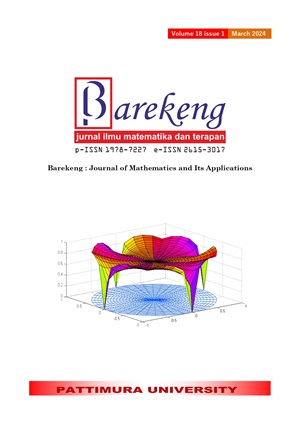LESLIE MATRIX CONSTRUCTION AND ITS PROPERTIES IN PREDICTING THE SIZE OF THE FEMALE POPULATION
Abstract
The growth of the female population needs to be considered because if the female population is not controlled, it is feared that it could trigger a population explosion. Using the Leslie matrix, this study aimed to predict the number and growth rate of the female population in Batugajah Village, Mdona Hyera Subdistrict, Southwest Maluku Regency. Based on the results of the study, the female population in Batugajah Village, Mdona Hyera Subdistrict, Southwest Maluku Regency, is predicted to be 157 people in 2021, 150 people in 2022, and 142 people in 2023. Furthermore, the most significant positive eigenvalue is 0.6521, which indicates that the population growth rate will tend to decrease.
Downloads
References
S. Yuliani, "Penerapan Diagonalisasi Matriks dan Matriks Leslie dalam," Universitas Negeri Semarang, Semarang, 2012.
Christine. Black and Christine. Black, Student solutions manual to accompany Elementary linear algebra with applications, 9th ed. Wiley & Sons, 2005.
M. O. Cáceres and I. Cáceres-Saez, “Random Leslie matrices in population dynamics,” J Math Biol, vol. 63, no. 3, pp. 519–556, Sep. 2011, doi: 10.1007/s00285-010-0378-0.
“Leslie Matrix Model in Population Dynamics,” 2007.
Y. Pratama, B. Prihandono, and N. Kusumastuti, “APLIKASI MATRIKS LESLIE UNTUK MEMPREDIKSI JUMLAH DAN LAJU PERTUMBUHAN SUATU POPULASI,” 2013.
D. Anggreini, R. Candra Hastari, and J. Pendidikan Matematika STKIP PGRI Tulungagung Jalan Mayor Sujadi Timur No, “Penerapan Matriks Leslie pada Angka Kelahiran dan Harapan Hidup Wanita di Provinsi Jawa Timur,” Pendidikan Matematika, vol. 12, no. 2, pp. 109–122, 2017, doi: 10.21831/pg.v12i2.15293.
H. Mustofa, “ANALISIS JUMLAH PERTUMBUHAN PENDUDUK PEREMPUAN KOTA PONTIANAK MENGGUNAKAN METODE MATRIKS LESLIE,” 2019.
Y. M. N. H. C. M. Corazon, "Aplikasi Matriks Leslie Untuk Memprediksi Jumlah Dan Laju," Jurnal Sains Matematika dan Statistika, vol. II, no. 1, 2016..
S. N. M. D. Pendidikan Matematika ; Th and S. P. S. P. M. F.-U. P. S. Semarang, “PENERAPAN MATRIKS LESLIE UNTUK MEMPREDIKSI JUMLAH DAN LAJU PERTUMBUHAN PEREMPUAN DI JAWA TENGAH PADA TAHUN 2020,” 2018.
H. BALQIS, "ANALISIS MODEL MATRIKS LESLIE DAN PENERAPANNYA DALAM MEMPREDIKSI JUMLAH DAN LAJU PERTUMBUHAN," UNIVERSITAS SUMATERA UTARA, Meda, 2021.
D. Anggreini and R. C. Hastari, “Leslie Matrix Application in Determining Number and Growth Rate of Female Population,” Proceeding International Conference on Science and Engineering, vol. 1, pp. 165–170, Oct. 2017, doi: 10.14421/icse.v1.295.
W. Sanusi, dan Nur Ridiawati, J. Matematika, and F. Matematika dan Ilmu Pengetahuan Alam, “Matriks Leslie dan Aplikasinya dalam Memprediksi Jumlah dan Laju pertumbuhan Penduduk di Kota Makassar,” 2018. [Online]. Available: http://www.ojs.unm.ac.id/jmathcos
A. Maryati and S. Supian, “Application of the Leslie Matrix to Predict the Number and Growth Rate of Women in West Java 2021,” International Journal of Quantitative Research and Modeling, vol. 2, no. 1, pp. 11–23, 2021, [Online]. Available: https://journal.rescollacomm.com/index.php/ijqrm/index
B. Desy, A. Prayanti, I. Gede, A. Wisnu Wardhana, and M. U. Romdhini, “LESLIE MATRIX ANALYSIS IN DEMOGRAPHIC MODEL,” J. Ris. & Ap. Mat, vol. 05, no. 02, pp. 118–124, 2021.
A. P. A. S. Latifa Auli Marizka, "KONSTRUKSI MATRIKS LESLIE DAN SIFAT-SIFATNYA," in Prosiding Seminar Nasional Matematika dan Terapannya, Purwokerto, 2022.
Copyright (c) 2024 Dyana Patty, Z. A. Leleury, J. A. Popla

This work is licensed under a Creative Commons Attribution-ShareAlike 4.0 International License.
Authors who publish with this Journal agree to the following terms:
- Author retain copyright and grant the journal right of first publication with the work simultaneously licensed under a creative commons attribution license that allow others to share the work within an acknowledgement of the work’s authorship and initial publication of this journal.
- Authors are able to enter into separate, additional contractual arrangement for the non-exclusive distribution of the journal’s published version of the work (e.g. acknowledgement of its initial publication in this journal).
- Authors are permitted and encouraged to post their work online (e.g. in institutional repositories or on their websites) prior to and during the submission process, as it can lead to productive exchanges, as well as earlier and greater citation of published works.






1.gif)



